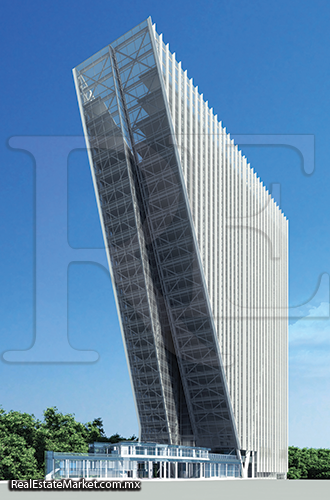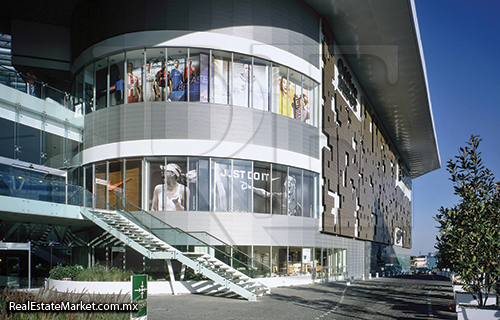Español
Hay inversionistas que gustan mucho de las bondades del mercado inmobiliario, pero el único problema que encuentran es la poca liquidez de los inmuebles. Justamente para ellos aparecieron los Fideicomisos de Inversión en Bienes Raíces (FIBRAS).
Buscando un instrumento que ofrezca “lo mejor de ambos mundos”, es decir, los beneficios de la inversión inmobiliaria con la facilidad de operación de un instrumento financiero, nació en México FIBRA, a través de la Bolsa Mexicana de Valores.

Corporativo Virreyes, México DF.
Visto de otra manera, el instrumento ofrece la oportunidad de gozar de las bondades propias de un mercado inmobiliario (rentas, plusvalía, etc.) y del atractivo de un instrumento financiero bursátil.
Como otra de sus bondades, las FIBRAS poseen las características de un fondo de inversión, porque se trata de fideicomisos que integran un portafolio de propiedades inmobiliarias.
Por estas características hay quien considera que es un instrumento híbrido:
- Los dividendos pagados por la generación de rentas que son relativamente predecibles y los hace parecer un instrumento de renta fija.
- Por la revaluación de inmuebles, que se ve reflejado en el valor del certificado de participación inmobiliaria, son un instrumento de renta variable. Precisamente la BMV los clasifica dentro del mercado de acciones.
EXPERIENCIA POSITIVA
Por ahora, el atractivo del nuevo instrumento financiero es el mercado inmobiliario mismo, derivado de variables positivas, como por ejemplo:
- En México no ha habido una burbuja de precios ni existe una amenaza de ello en los mercados residencial y comercial en su conjunto. Tampoco hay exceso de oferta.
- El presente año será el cuarto consecutivo con crecimiento económico, lo que se ha traducido en grandes inversiones en el sector manufacturero, derivado de ello ha crecido la demanda por espacios industriales y de oficinas.
- El crecimiento del empleo en este ciclo de expansión económica, más la estabilidad de la inflación y el creciente crédito al consumo, han fortalecido la capacidad de consumo de las familias mexicanas, por lo mismo nuevamente se generaron las condiciones para una creciente inversión en centros comerciales.
-La oferta de crédito hipotecario, tanto de organismos públicos como de la banca privada, sigue en aumento. Por ello, aunque cada vez hay mayor penetración de la vivienda usada, también hay condiciones para continuar con una buena dinámica en el sector residencial.
Como una de las máximas en materia de inversión es la diversificación, las Fibras ofrecen portafolios diversificados como FUNO, pero también especializados como es el caso de TERRA y MQ, que se han concentrado en el mercado de parques industriales, así como FIHO y FINN, que se especializan en hoteles.
| Las razones del éxito |
|---|
|
Un análisis de la casa de la bolsa Actinver indicó que la inversión en FIBRAS resulta atractiva y enumera una serie de razones para ello:
|
¿CÓMO OPERAN?
Un análisis de BBVA Reserach señaló que las FIBRAS se basan en el esquema de los fideicomisos de inversión en el sector inmobiliario de Estados Unidos conocidos como REITs (Real Estate Investment Trust).
Un REIT funciona como una empresa que administra y opera diferentes bienes raíces.
Los REITs se han caracterizado por ser un instrumento de inversión transparente, de rendimiento competitivo e incluso mayor al otorgado por inversiones en índices de acciones de ese país.

Puntos para crecimiento, Gran Terraza , Lomas Verdes. /
Su expansión ha sido acelerada desde mediados de la década de 1990 y se ha acentuado a partir de 2000.
Así, al cierre de octubre de 2006 el valor de capitalización de mercado de los 134 REIT que existían en Estados Unidos alcanzó 373.5 mil millones de dólares, cifra casi 2.7 veces superior a la existente al cierre de 2000.
BBVA Research señaló que las FIBRAS se perfilan como importantes instrumentos de inversión que no solo diversificarán riesgos para sus inversionistas, sino que ampliarán la gama de fuentes de financiamiento para proyectos inmobiliarios rentables y de gran demanda. Constituyen un favorable esquema de inversión en el que podrán basar su financiamiento los futuros desarrollos inmobiliarios. Los poco más de dos años de cotización de las FIBRAS en México han confirmado la afirmación del análisis citado.
De acuerdo con cifras a junio del año en curso, el rendimiento promedio de las FIBRAS que cotizan en bolsa hasta ahora es de 40% anual. Sin embargo, es muy probable que para el futuro de largo plazo esos rendimientos se vayan haciendo mucho más pequeños. Hace cerca de seis años BBVA Bancomer señalaba que “el reto para las autoridades es continuar avanzando en mejorar el tratamiento fiscal para lograr convertir a las FIBRAS en una alternativa de inversión atractiva y redituable, a la vez que se constituyan como un vehículo eficaz para dotar de liquidez al mercado inmobiliario para fortalecerlo y fomentarlo. El atractivo que los Fibras despierten entre los inversionistas estará en función de su rendimiento y de su riesgo, y entre más acoten este último mejores serán sus perspectivas”.
La experiencia en México de poco más de dos años ha validado este escenario.

Glabes Emory Point, Atlanta.
Texto Ricardo Vázquez
Foto: DANHOS, VIVA PLAZAS, COUSIN PROPERTIES, GRUPO ARCHITECH
English
The best of two worlds
There are investors which like the kindness of the real estate market, the only problem they find is the little liquidy in the estates. Just for them the trust fund of investment and real estate or Fideicomisos de Inversión y Bienes Raíces (FIBRAS) appeared. Searching for an instrument that can offer “the best of both worlds” this means, the benefits of the real estate investment with the operation facility of a financial instrument, FIBRA was born in Mexico through the Mexican Stock Exchange.
Seen in another way, the instrument offers the opportunity to enjoy the kindness proper of a real estate market (rents, plus value, etc) and from the attractive bursarial instrument. Other kindness is the FIBRAS which possess the characteristics of a investment fund, because it a trust fund which integrates into a property real estate portfolio. Due to these characteristics there are those who consider this as a hybrid instrument:
- The dividends paid by the generation of rent are relatively predictable and makes them seem like a fixed rent instrument.
- Due to the revaluation of the estates, which is reflected in the certified value of estate participation, they are instruments of variable rent. Precisely the Mexican Stock Exchange of Bolsa Mexicana de Valores (BMV) classifies them in the stock market.
POSITIVE EXPERIENCE
For now, the attractive part of this financial instrument is the real estate market itself, derivative of positive variables, for example:
-In Mexico there hasn’t been a price bubble nor does the thread exists in the residential and commercial markets together. There hasn’t been an excess of offers.
-The present year will be the fourth in a row with economic growth, which has been translated to great investments in the manufacture sector, derivative of this has been the demand for industrial spaces and offices.
- The growth of employment in the cycle has economically expanded, plus the stability of inflation and the growing credit consumption, they have fortified the capacity in consumption of Mexican families, are once again generated under conditions for a growing investment in commercial centers.
- The offer of mortgage credits, as well as public organisms in private banking is still in the rise. Because of this, although the penetration is even higher in used households, there are also conditions to continue this good dynamic in the residential sector. As one of the maximum investment subject of diversification, the FIBRAs offer portfolios sectioned as FUNO, but they are also specialized as in the case of TERRA and MQ, which have concentrated in the industrial parks market, like wise FIHO and FINN, have expertise in hotels.
| The reasons for success |
|---|
|
A analysis made by the stock house Actinver indicated the investment in FIBRAS results active and enumerates a series of reasons:
|
HOW DO THEY OPPERATE?
A BBVA Reserach analysis pointed out that FIBRAS are based in a trust fund real estate sector rank of the United States known as REITs (Real Estate Investment Trust).
A REIT works as an administrative enterprise, which administrates and operates different real estates.
REITs have been characterized for being a transparent investment instrument, of competitive performance or even higher to the one given by investors in the stock index of the country.

Puntos para crecimiento, Gran Terraza , Lomas Verdes. /
Its expansion has been accelerated since midst of the 1990 decade and has accentuated since 2000. This way, by the end of October of 2006 the capitalization value of the market from the 134 REIT that existed in the United States reached 373.5 thousand million dollars, sum almost 2.7 times superior to the existent in 2000.
BBVA Research pointed out that FIBRAs are profiled as important instruments for investment that not only diversify risks for their investors, but they also amplify the range of financement sources for their rentable real estate projects and great demand.
They constitute a favorable group of investments which future financial developments in real estate could be based. The two years of contributions of the FIBRAS in Mexico has confirmed the affirmation of the previous analysis. According to the numbers of June of 2013, the average performance of the FIBRAs listed in the stock until now of a 40% annually. However, it is very likely that in a long term future these will be getting smaller.
Nearly six years ago BBVA Bancomer pointed out “the challenge for authorities is to continue advancing the improvement of fiscal treatment to achieve the transformation of FIBRAS in an investment attractive and redeemable option, at the same time that they are built into a efficiency vehicle to gift liquids to the real estate market in order to strength and encourage it.
The attractive FIBRAS create amongst investors will be seen in unison with its performance and risk, as long as they delimit this last one, the better they will in perspective” The experience in Mexico of a little over than a year has validated this new scenario.

Glabes Emory Point, Atlanta.
Text: Ricardo Vázquez
Photo: DANHOS, VIVA PLAZAS, COUSIN PROPERTIES, GRUPO ARCHITECH
